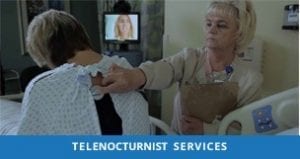At ATA Fall Forum, Eagle will share how nighttime telehospitalist care gains widespread use in rural and metropolitan hospitals to reduce physician burnout, close nocturnal staffing gaps
NEW ORLEANS, LA—Sept. 28, 2016—With a long track record of helping rural hospitals increase patient census and avoid transfers, telemedicine is also proving successful in addressing nocturnal staffing gaps at hospitals of all sizes, rural and metropolitan alike. Eagle Telemedicine will share success stories and best practices at the American Telemedicine Association’s Fall Forum Sept. 28-30, 2016, in New Orleans.
Eagle Telemedicine representatives will be at Booth #107 throughout the conference, and invite attendees to visit and register for a raffle for a free iPad mini.
“The Fall F orum will cover how telemedicine is evolving to meet the needs of hospitals today, and our telenocturnist services are a prime example,” said Dr. Talbot “Mac” McCormick, President and CEO of Eagle, a physician-led hospitalist management firm providing turnkey programs, Clinical Performance Management (CPM) solutions, and telemedicine services. “When we began our telemedicine program eight years ago, our first clients were rural hospitals hit hard by the physician shortage, and frequently overloading their daytime physicians with nighttime rounding responsibilities.”
orum will cover how telemedicine is evolving to meet the needs of hospitals today, and our telenocturnist services are a prime example,” said Dr. Talbot “Mac” McCormick, President and CEO of Eagle, a physician-led hospitalist management firm providing turnkey programs, Clinical Performance Management (CPM) solutions, and telemedicine services. “When we began our telemedicine program eight years ago, our first clients were rural hospitals hit hard by the physician shortage, and frequently overloading their daytime physicians with nighttime rounding responsibilities.”
According to Dr. McCormick, larger hospitals are now looking to telemedicine to solve their night staffing issues. “In larger hospitals, nighttime admissions are more frequent, and ED physicians are often expected to do double-duty by handling cross-coverage calls on the floor. A high-stress working environment is made even more stressful. Our solutions help hospitals address the problem.”
Results are impressive
Hospitals working with Eagle have also achieved these results:
- Up to 40% savings on nighttime coverage
- 50% increase in nighttime admissions
- An average response time of 1 minute and 9 seconds from the time nurses call telehospitalists to the time the physician is interacting remotely with patients
Though telemedicine can include many types of electronic communication, Eagle’s approach uses a cart or robot on wheels with a two-way videoconferencing monitor that brings a patient face-to-face with a physician “beamed in” from a remote location. The physician and patient have direct interaction, and the technology enables the physician to monitor the patient remotely with a stethoscope, otoscope, and blood pressure gauge. It can also transmit still images such as photos and X-rays for interpretation by the physician.
Maximizing quality of care
“Hospitals are able to attract and keep patients that they might otherwise lose because of specialty coverage gaps,” Dr. McCormick said. In addition, using critical care coverage through telemedicine can assist hospitals in achieving Leapfrog standards, and maximizing the quality and efficiency of ICU care. And engaging telemedicine to cover nights and weekends can help with the recruitment and retention of specialists.
“Nocturnists often have to be in two places at once in busy hospitals: handling admissions and rounding in the ED, while also providing floor call consultations. Stress and burnout frequently result from this overload. Eagle Telecross-Coverage resolves the problem,” Dr. McCormick said. “We look forward to discussing our solutions with ATA conference attendees.”